Email marketing is an essential part of digital marketing that many companies and businesses still use to this day. The ROI for email marketing is $44 for every $1 spent, which clearly indicates that there is plenty of value to be gained in this area.
It remains an essential method of advertising for businesses and services, whether you are an established brand or just starting out.
In this article, we are going to delve into what exactly email marketing is, as well as unpacking all the top email marketing statistics, illustrating precisely why it’s still an integral part of digital marketing.
Email Marketing Facts and Stats [Key Findings]
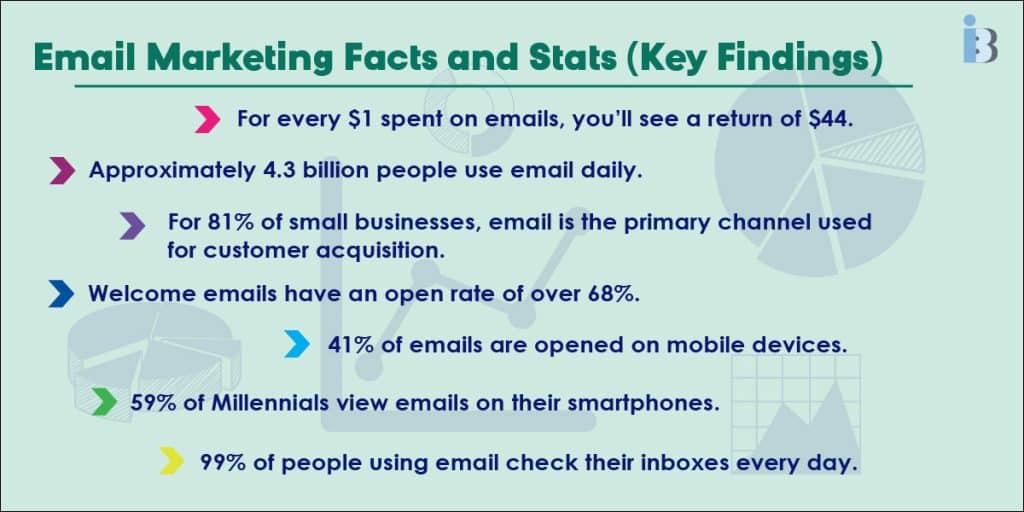
- For every $1 spent on emails, you’ll see a return of $44.
- Approximately 4.3 billion people use email daily.
- For 81% of small businesses, email is the primary channel used for customer acquisition.
- Welcome emails have an open rate of over 68%.
- 41% of emails are opened on mobile devices.
- 59% of Millennials view emails on their smartphones.
- 99% of people using email check their inboxes every day.
What Is Email Marketing?
Simply put, it’s sending out emails to different companies or individuals to promote your business and services. It’s also important for developing your relationships with existing clients while creating opportunities to connect with new ones.
It’s an excellent tool for keeping your existing customer base in the loop with what’s going on with your business. You can adjust your emails to better suit their individual needs and interests. It’s also highly cost-effective compared to other forms of digital marketing and can achieve impressive results for your ecommerce business.
General Email Marketing Statistics
- Email marketing’s revenue at the end of 2023 is estimated to be around $11 billion.
- 1 in 2 media planners utilize email marketing.
- The growth is forecast to increase by around 22% this year.
- The number of daily email users is around 4 billion people and by 2025, that number will increase to 4.6 billion.
- Email marketing is used by around 64% of small businesses and companies.
- Around 306 billion emails are sent on a daily basis.
- The email budget of 37% of brands is being increased while only 1.3% of brands are making any cuts.
- Weekly emails are sent by 33% of marketers, while 26% of marketers send emails more than once during a single month.
Email Marketing Usage
In this section, we will be diving into statistics that focus specifically on the usage of email marketing. The greatest advantage of email marketing is that almost everyone uses email and has an email address.
- 92% of adults have an email address that they use and around 61% send an email on a daily basis.
- Apart from the fact that it’s almost universally used by adults on the internet, the number of email users is increasing every single day. The overall amount of people using emails in the US in 2020 was estimated to be 251.8 million.
- With around 105 billion emails being sent on a daily basis, it’s estimated that the number will rise to 246 billion by 2025.
- Individuals don’t only use email to communicate with friends and family. Around 61% of the people polled stated that their preferred method of being contacted by companies and brands was via email.
Global Email Marketing Revenue
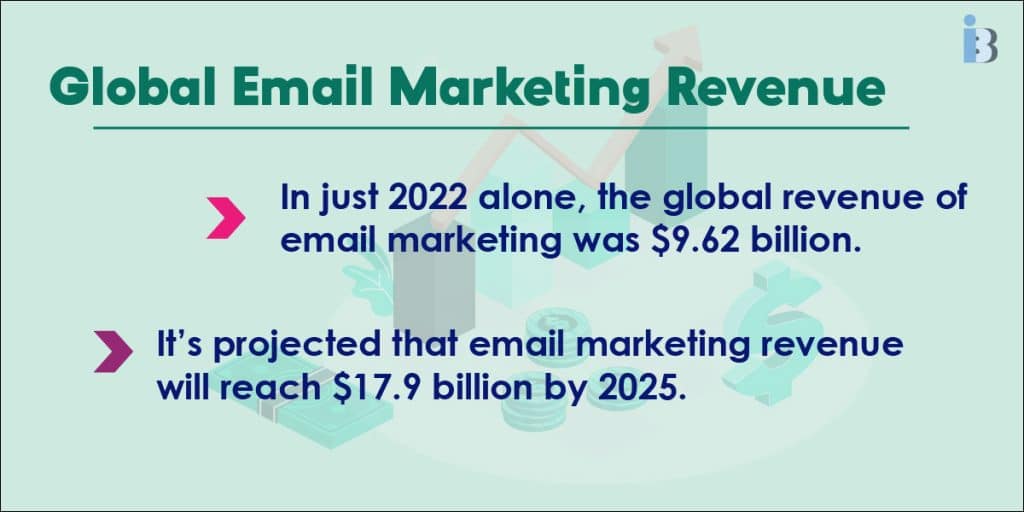
The revenue and ROI generated by email marketing, although already indisputably valuable to businesses and companies, are set to increase exponentially in the near future.
- In just 2022 alone, the global revenue of email marketing was $9.62 billion.
- It’s projected that email marketing revenue will reach $17.9 billion by 2025.
Emails Sent and Received Daily
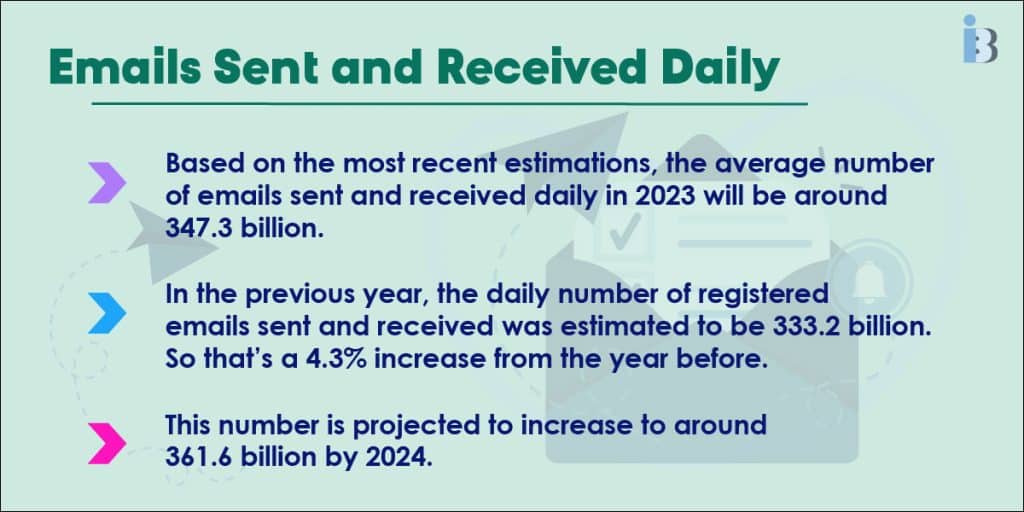
- Based on the most recent estimations, the average number of emails sent and received daily in 2023 will be around 347.3 billion.
- In the previous year, the daily number of registered emails sent and received was estimated to be 333.2 billion. So that’s a 4.3% increase from the year before.
- This number is projected to increase to around 361.6 billion by 2024.
This is an impressive statistic, especially when you consider that many experts were of the opinion that emails would become obsolete by 2020, due to the popularity of instant messaging apps like Slack and WhatsApp. However, this doesn’t seem to be the case at all based on current projections.
Having trouble with your email lists? Check out my blog post on the top email verification tools.
Email Open Rate for Businesses
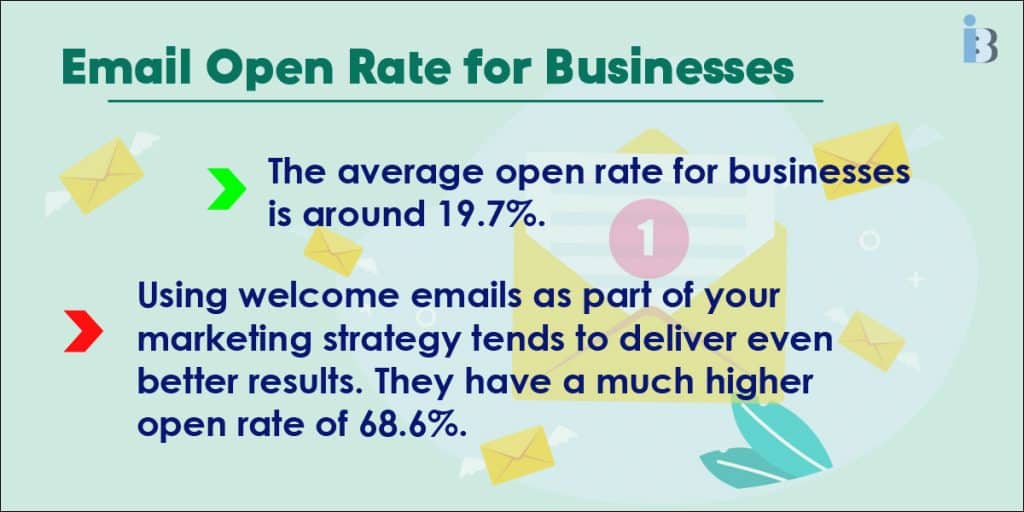
Open rates are among the most effective email marketing KPIs for understanding how well your strategy is performing. Your email open rate tells you the percentage of subscribers who open a particular email out of your total number of subscribers.
- The average open rate for businesses is around 19.7%.
- Using welcome emails as part of your marketing strategy tends to deliver even better results. They have a much higher open rate of 68.6%.
That’s why it’s a good idea to include all the useful information about your business/brand in your welcome emails.
Enticing Mobile Email Marketing Statistics
Most email views are actually from mobile devices rather than people’s desktops.
- The statistic for mobile views is 41% while desktop views are 39%.
- Excluding tablets, mobile devices generate 55% of global website traffic.
- In terms of the highest market share, first place goes to Apple iPhone’s native email app, with Gmail being second.
- With this in mind, it’s crucial to launch an email design that is mobile-responsive. Doing so has the potential to increase your click rate by 15%.
- Mobile-friendly emails are used by 56% of marketers as part of their email marketing strategy.
B2B Email Marketing Statistics
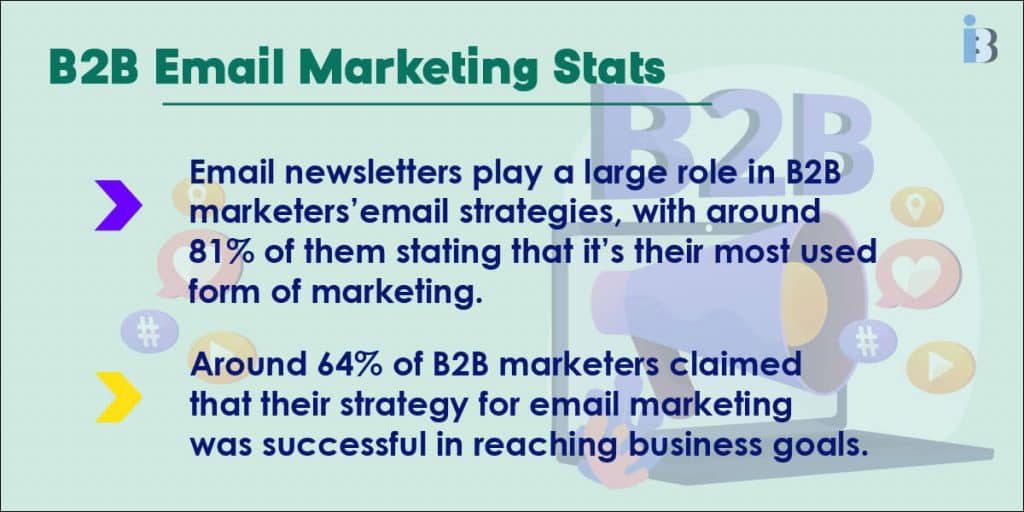
- Email newsletters play a large role in B2B marketers’ email strategies, with around 81% of them stating that it’s their most used form of marketing.
- Around 64% of B2B marketers claimed that their strategy for email marketing was successful in reaching business goals.
According to B2B marketers, new feature announcements and product emails usually have the highest click-through rates. Automation is utilized mainly for segmentation, nurture campaigns, dip, and sending triggering emails.
Looking for B2B prospects. Read my Tomba.io review to find out how to discover them.
B2C Email Marketing Statistics
- Automation is a fundamental part of B2C email marketing, with it being leveraged by 87% of marketers.
- Studies have found that it’s important not to bombard your audience with more than 5 newsletters per week. Doing so can actually negatively impact your click and open rates.
- According to 59% of people asked in a survey, marketing emails played a big part in their purchasing decisions.
- Email marketing is a key component influencing customer retention, according to 80% of business professionals. In order to take advantage of discounts and savings, many people subscribe to email lists.
- It’s estimated that around 42.3% of people in the United States are subscribed to email lists.
- This is coupled with the fact that 1 in 3 people are subscribed to a brand’s retail email list and have actually purchased something from that brand.
Email Marketing Statistics by Industry
When it comes to email automation, around 49% of brands use some form of it. Apart from the fact that email automation is widespread, we also need to take a look at which industries get the most mileage out of email marketing.
Here are the industries with the highest email open rates:
- Nonprofit—20.39%
- Forestry, fishing, agriculture, and hunting—20.13%
- Government—19.79%
- Healthcare services—19.12%
Meanwhile, the industries with the highest click-to-open rates are as follows:
- Real estate, design, and construction—17.2%
- Education—15.7%
- Government and politics—14.3%
- Healthcare services—13.4%
A great way to increase email open rates and click-to-open rates is through personalized emails.
Personalized Email Marketing Statistics
Personalizing the emails you send to consumers based on their individual interests and preferences is crucial.
Why? Let’s take a closer look:
- 74% of people cannot stand being bombarded with emails full of irrelevant content and information.
- Around 77% of marketers surveyed said that they used emails to send personalized content to their customers or consumers. It’s an excellent way for them to receive relevant offers that appeal to their sensibilities.
- A well-constructed personalized email is estimated to yield 6 times higher transaction rates.
- It’s estimated that you receive a 26% increase in open rates if you personalize your email subject line. In essence, the more effort you put into personalizing each of your emails, the more likely viewers are to engage with it.
- There are numerous factors to take into account when creating personalized emails, e.g., gender and age.
- Around 66% of companies use age data as a factor in determining how to personalize the emails they send.
Another component to build your personalized emails around is a customer’s previous purchases or data connected to specific actions and decisions they’ve made regarding their purchases. For instance, Netflix recommends new shows or movies to viewers using data based on things they’ve previously watched.
Are you ready to elevate your online business? Discover essential insights from the latest digital marketing statistics—click to read more!
Email Engagement Statistics
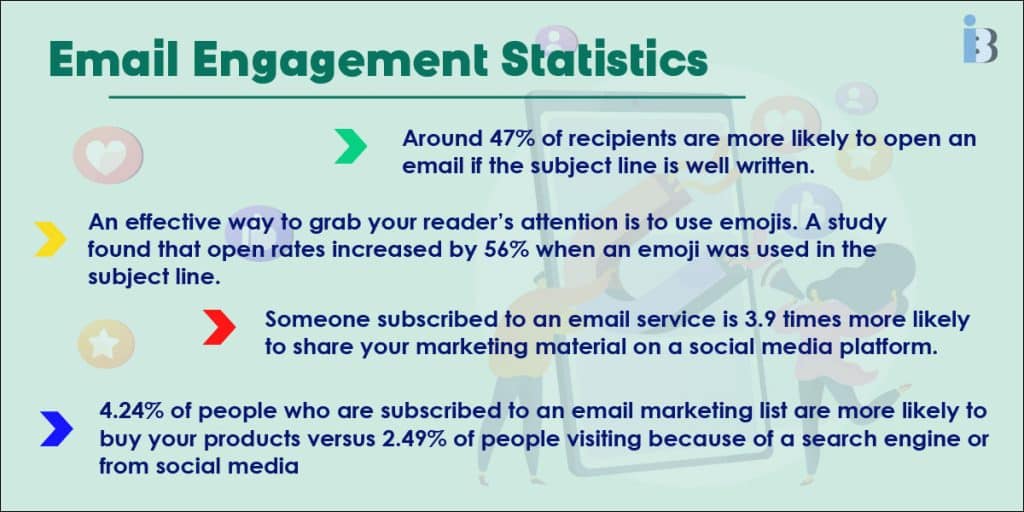
Here we’ll be examining some other factors that can increase email engagement and the relevant statistics tied to them. As previously mentioned, email subject lines play a substantial role in whether the recipient engages with your offer or not.
- Around 47% of recipients are more likely to open an email if the subject line is well written.
- An effective way to grab your reader’s attention is to use emojis. A study found that open rates increased by 56% when an emoji was used in the subject line.
- Someone subscribed to an email service is 3.9 times more likely to share your marketing material on a social media platform.
- 4.24% of people who are subscribed to an email marketing list are more likely to buy your products versus 2.49% of people visiting because of a search engine or from social media.
The Benefits of Email Marketing
Hopefully, unpacking the statistics in this article has helped you understand just how beneficial email marketing can really be.
Let’s go over some other stats related to email ROI and email marketing conversions:
- 30% of marketers from around the world claim that email marketing has the highest marketing ROI.
- For every $1 spent, you get a return of $44. That’s basically 4400% in terms of ROI.
- Email marketing is 40x more likely to attract consumers compared to the numbers brought by Facebook and Twitter combined.
- The amount consumers spend is 138% higher when they discover information through email marketing, in contrast to those that don’t get emails.
- An email address has a dollar value. The value depends on the email and consumer habits of the person behind it, with an average value of $113.48 per contact.
Final Thoughts
All of these statistics have clearly demonstrated the efficacy of email marketing, which remains a powerful cornerstone of digital marketing.
Emails are still widely used in B2B and B2C strategies. They are a valuable asset for businesses of all sizes.
If you want to enhance your email campaigns, check out this article about the best email marketing tools. It’s based on survey results.
FAQ
Is email marketing effective?
Email marketing is almost 40x times more effective than social media (X and Facebook combined) in terms of acquiring customers.
What is email marketing’s ROI?
The ROI on email marketing is as high as 4400%—you see a return of $44 for every $1 spent.
What is email marketing’s success rate?
Business email open rate is 19.7% on average. While welcome emails can reach an open rate of almost 69%.
What is the 80/20 rule in email marketing?
The 80/20 email marketing rule refers to the ratio you should follow between content providing value to your customer (80%) and promotional content (20%).
References
- https://www.statista.com/statistics/255080/number-of-e-mail-users-worldwide/
- https://www.litmus.com/blog/2021-state-of-email
- https://www.statista.com/statistics/750858/us-consumers-preferences-brand-contact/
- https://www.statista.com/statistics/812060/email-marketing-revenue-worldwide/
- https://www.getresponse.com/resources/reports/email-marketing-benchmarks
- https://www.statista.com/statistics/456500/daily-number-of-e-mails-worldwide/
- https://www.mckinsey.com/capabilities/growth-marketing-and-sales/our-insights/why-marketers-should-keep-sending-you-emails
- https://blog.hubspot.com/marketing/email-marketing-stats
![The Best Email Marketing Tools to Boost Your Campaigns in 2024 [Based on Survey Results] Best Email Marketing Tools](https://inboundblogging.com/wp-content/uploads/2024/08/best-email-marketing-tools-150x150.jpg)


![The Ultimate Guide to Marketing Automation for Small Business [+Top Tools From My Survey] Marketing Automation for Small Business](https://inboundblogging.com/wp-content/uploads/2024/11/marketing-automation-tools-for-small-business-150x150.jpg)